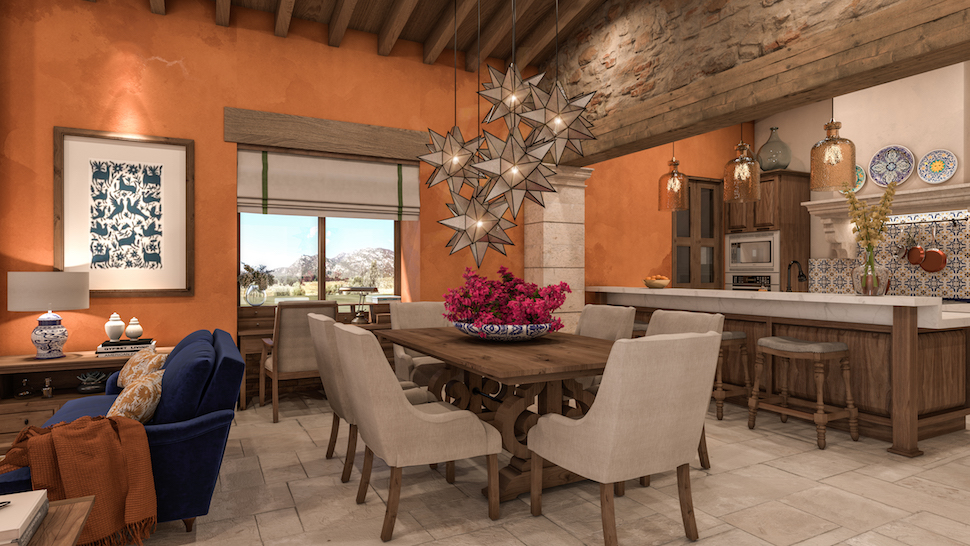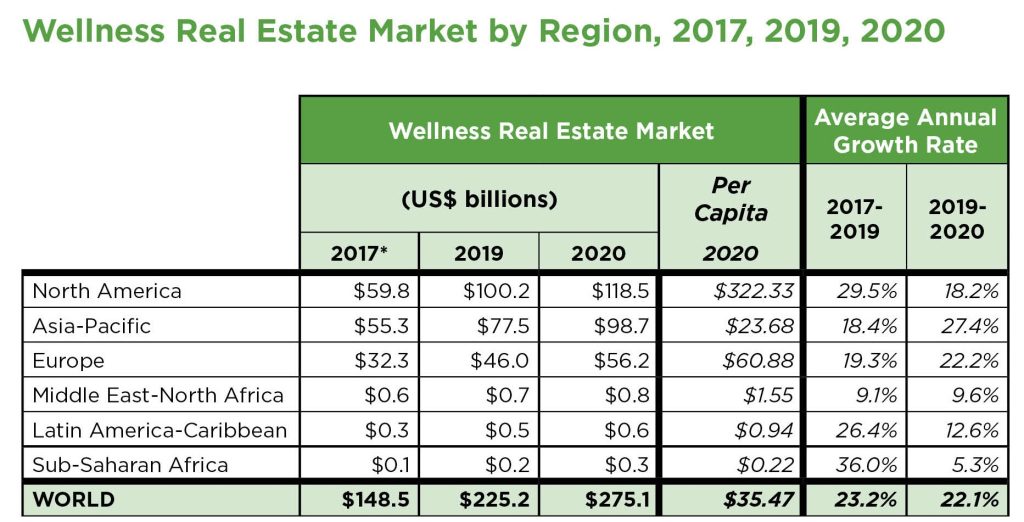
The nonprofit Global Wellness Institute (GWI), today unveiled new data for the wellness real estate market revealing extraordinary recent growth. From 2017 to 2020, the global market grew 22 percent on average annually, expanding from $148 billion in 2017 to $225 billion in 2019 to $275 billion in 2020. Wellness residential projects skyrocketed in those three short years, from 740 in 2017 to over 2,300 today.
The market surged in the two years before the pandemic (2017 to 2019): Wellness real estate grew 23 percent each year compared with 5.4 percent growth for construction overall (and this disconnect remained true for every global region). The new research also makes it clear the pandemic further fueled the shift in the real estate and construction industries toward wellness: from 2019 to 2020, wellness real estate continued to grow by over 22 percent, even as overall construction shrank by -2.5 percent.
First to Define & Measure Sector
The GWI was first to define and measure this sector in its 2018 “Build Well to Live Well” report. The new report, “Wellness Real Estate: Looking Beyond COVID-19,” provides market data and growth rates for both 2017 to 2019 and 2019 to 2020 (to capture “the pandemic effect”) for every global region and the top 20 national markets—as well as forecasting key shifts that will define the market post-COVID.
“The pandemic has driven the idea of ‘building for human health’ into the mainstream consumer consciousness, and the recent market growth far exceeded our predictions, as well as general economic growth trends.”—Ophelia Yeung
Research highlights were presented at the GWI’s Wellness Real Estate & Communities Symposium today in NYC, the first event to bring together investors, developers, architects, designers, and medical experts to discuss the future of this market. Learn more about accessing the full day of presentations and research package.
“Just three years ago, wellness real estate was a concept not well understood by consumers, builders, developers or investors, but we predicted demand would soon hit like a tsunami. That moment has arrived,” said Ophelia Yeung, GWI senior research fellow. “The pandemic has driven the idea of ‘building for human health’ into the mainstream consumer consciousness, and the recent market growth far exceeded our predictions, as well as general economic growth trends.”
Key Findings
A Definition: The GWI defines wellness real estate as the construction of residential and commercial/institutional properties (including office, hospital, mixed-use/multifamily, medical, and leisure) that incorporate intentional wellness elements in their design, materials, and building, as well as their amenities, services and/or programming.
Huge Market Gains Worldwide:

Wellness real estate is heavily concentrated in North America, Asia-Pacific, and Europe, and each market clocked exponential recent growth, with the North American and Asian markets essentially doubling from 2017 to 2020.

Seven countries—the US, China, Australia, UK, Japan, France, and Germany—account for 82 percent of the wellness real estate market; the US and China alone comprise roughly 60 percent. But the full data on the top 20 markets reveals striking 2017 to 2020 growth across the board. Japan (360 percent growth) and Canada (240 percent growth) are standouts, while the US, China, UK, France, Netherlands, Denmark, Switzerland, Singapore, Norway, Italy, and Finland essentially doubled their markets.
An Exploding, More Diverse Pipeline
If the GWI identified 740 wellness residential projects in 2018, the sector has since grown so fast that the projects are too numerous to properly count. Today, the GWI conservatively estimates that there are over 2,300 wellness projects worldwide (either built, partially built, or in development). Wellness living concepts are being developed in all types of residential projects: master-planned communities; multifamily projects (apartments, condominiums); urban districts and mixed-use projects; resort/spa/hospitality-based wellness real estate; affordable/subsidized housing; and other wellness concepts based on eco-communities, co-living, senior living, and more—taking an increasingly dizzying number of “wellness angles.”
“So many macro forces—our fast-aging world, our stress and loneliness crises, the rise of remote work, a consumer demanding more sustainable living—means the growth trajectory for wellness homes and building design will only rise,” said Katherine Johnston, GWI senior research fellow. “But COVID-19 forced us to see our homes and built environment in a radically new light, as the protectors and enablers of our very health and wellbeing. Wellness real estate is now quickly moving from elective to essential.”